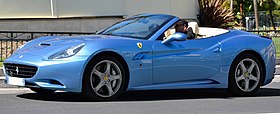Ferrari California
| Ferrari California | |
|---|---|
 |
|
| Overview | |
| Manufacturer | Ferrari |
| Production | 2008–present |
| Assembly | Maranello, Italy |
| Body and chassis | |
| Class | Grand tourer (S) |
| Body style | 2-door, 2+2 coupé cabriolet |
| Layout | Front mid-engine, rear-wheel drive |
| Ferrari California | |
|---|---|
 |
|
| Overview | |
| Production | 2008–2013 |
| Designer | Pininfarina |
| Powertrain | |
| Engine | 4.3 L Ferrari F136 I V8 |
| Transmission | 7-speed dual-clutch 6-speed manual |
| Dimensions | |
| Wheelbase | 2,670 mm (105.1 in) |
| Length | 4,563 mm (179.6 in) |
| Width | 1,902 mm (74.9 in) |
| Height | 1,308 mm (51.5 in) |
| Kerb weight |
|
| Chronology | |
| Successor | Ferrari California T |
| Ferrari California T | |
|---|---|
 |
|
| Overview | |
| Production | 2014–present |
| Model years | 2015–present |
| Designer | Centro Stile Ferrari in collaboration with Pininfarina |
| Powertrain | |
| Engine | 3.9 L Ferrari F154 BB twin-turbo V8 |
| Transmission | 7-speed dual-clutch |
| Dimensions | |
| Wheelbase | 2,670 mm (105.1 in) |
| Length | 4,570 mm (179.9 in) |
| Width | 1,910 mm (75.2 in) |
| Height | 1,322 mm (52.0 in) |
| Kerb weight |
|
| Chronology | |
| Predecessor | Ferrari California |
The Ferrari California is a grand touring sports car produced by the Italian manufacturer Ferrari. It is a two-door 2+2 hard top convertible. When originally released, the California was powered by a front-mid mounted naturally aspirated 4.3-litre V8; in 2014 Ferrari introduced the second generation of the model, named California T and using a new twin-turbo 3.9-litre V8. The car revives the name used on the late-1950s Ferrari 250 GT Spyder California and the 1960s 365 California. It is also noted in being the least expensive model in the Ferrari range.
The California was launched at the 2008 Paris Motor Show. According to industry rumours, the California originally started as a concept for a new Maserati, but the resulting expense to produce the car led the Fiat Group to badge it as a Ferrari in order to justify the high cost of purchase; the company denies this, however. The California represents a new, fourth model range for the company.
The California represents a number of firsts for Ferrari:
Bosch produced the direct injection system. The engine displaces 4,297 cubic centimetres (262.2 cubic inches), and used gasoline direct injection. It delivers 338 kW (453 bhp) at 7,750 rpm; its maximum torque produced is 485 N·m (358 lbf·ft) at 5,000 rpm. The resulting 79 kW (106 bhp) per litre of engine displacement is one of the highest for a naturally aspirated engine, as other manufacturers have used supercharging or turbocharging to reach similar power levels. The body computer system was developed by Magneti Marelli Automotive Lighting.
The original 2010 California had a top speed of 310 km/h (193 mph) and it could accelerate from zero to 100 km/h (62 mph) in under four seconds. Although that model was 180 kilograms (397 lb) heavier and 30 PS (22 kW; 30 hp) less powerful than the mid-engined F430, the California reached 97 km/h (60 mph) in the same time as the F430 due to the dual-clutch transmission.
...
Wikipedia
